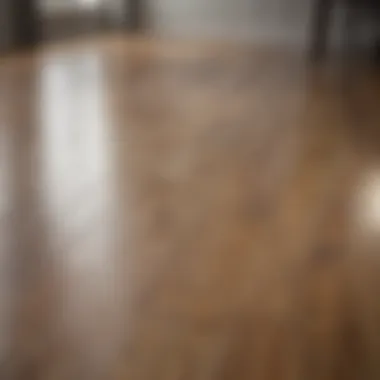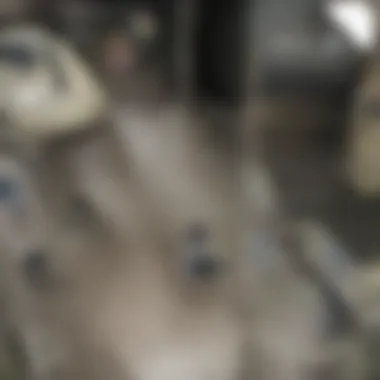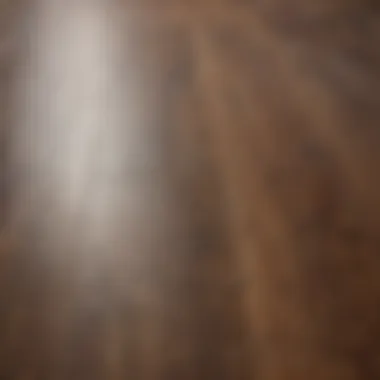Mopping Laminate Floors with Vinegar: A Comprehensive Guide


Intro
Maintaining the aesthetic appeal and longevity of laminate flooring is a priority for many homeowners and renters alike. One popular method for cleaning laminate floors is using vinegar, a common household item. While vinegar serves as an effective cleaning agent, there are various factors to consider to ensure safe usage. This guide examines the pros and cons of using vinegar on laminate, provides practical advice on the cleaning process, and addresses frequent concerns related to laminate floor maintenance.
Cleaning laminate floors is not just about aesthetics; it also protects the flooring from potential damage. Understanding the right cleaning solutions and methods can significantly affect the durability of these surfaces. In this guide, we aim to provide actionable insights to help individuals maintain their laminate floors with confidence and ease.
Prologue to Laminate Floors
Laminate flooring has become a popular choice among many homeowners and renters. Its versatility and affordability are just two key factors that attract individuals. In this article, we will explore the importance of understanding laminate floors. Knowing how laminate is made and its characteristics can influence how you maintain your flooring effectively. The specific elements such as durability, design options, and ease of installation make laminate a practical solution for various spaces.
Understanding Laminate Flooring
Laminate flooring is a synthetic product designed to mimic wood or stone floors. It typically consists of four layers: the backing layer, the core layer, the design layer, and the wear layer. Each layer contributes to the overall resilience and appeal of the flooring. The backing layer provides stability, while the core layer offers resistance to moisture and damage. The design layer provides the aesthetic value, resembling real wood or stone. Lastly, the wear layer protects against scratches and stains. This construct explains why laminate is often preferred for high-traffic areas.
Benefits of Laminated Surfaces
Laminated surfaces offer several advantages to homeowners and interior design enthusiasts. Some of these benefits include:
- Cost-Effective: Laminate flooring is generally more affordable than natural wood or stone options. This makes it accessible to a wider audience.
- Variety of Designs: With many colors, patterns, and textures, laminate can suit various styles. You can find options that blend with traditional or modern decor.
- Easy Installation: Many laminate products feature a click-lock method. This allows for quicker installation compared to more labor-intensive materials.
- Durability: Resilience to scratches, stains, and fading makes laminate an excellent choice for busy households. It withstands everyday wear and tear effectively.
With these factors in mind, understanding laminate flooring sets the stage for proper maintenance, including the safe and effective cleaning methods outlined in this guide. Knowing its properties enables better decision-making for home care.
The Role of Cleaning in Floor Maintenance
Cleaning plays a critical role in the overall maintenance of laminate floors. Regular upkeep not only preserves the aesthetic appeal of the flooring but also extends its lifespan. Dirt, dust, and debris can accumulate, gradually degrading the surface and leading to permanent damage if not addressed promptly. Hence, understanding how to maintain these surfaces properly is crucial for any homeowner.
Importance of Regular Cleaning
Regular cleaning is essential for laminate floors for several reasons. First, it helps in preventing the build-up of dirt that can scratch or dull the surface. This is particularly important for high-traffic areas where foot traffic can introduce a lot of grime. Secondly, cleaning reduces allergens and bacteria that may thrive in accumulated dust. By maintaining a clean environment, homeowners can contribute to better indoor air quality and overall health.
Furthermore, a consistent cleaning routine can enhance the original luster and color of the laminate, making spaces look fresher. Regular cleaning helps in identifying potential issues early, such as water damage or scratches, which might escalate into more significant problems if overlooked. Homeowners should pay attention and set a regular schedule to manage cleaning tasks effectively.
Choosing the Right Cleaning Methods
Selecting the appropriate cleaning method is a vital aspect of maintaining laminate flooring. Not all cleaning solutions are safe, and using the wrong products can lead to irreversible damage. Many traditional cleaners contain harsh chemicals that may affect the laminate’s finish.
It is advisable to use products specifically designed for laminate floors. One such safe alternative is a vinegar solution. Vinegar is a natural cleaner that effectively removes stains and dirt without harming the surface. However, not all cleaning practices are suitable, which makes it essential to evaluate various options.
Considerations include:
- Type of Floor: Different laminate finishes may react differently with certain products.
- Stain Type: Some stains require specific cleaning agents for effective removal.
- Frequency of Cleaning: Regular cleaning can often be managed with simpler methods, while deeper cleans might require more specific solutions.
By being cautious and informed about the cleaning methods chosen, homeowners can ensure that their laminate floors remain in excellent condition for years to come.
Why Use Vinegar for Cleaning


Using vinegar as a cleaning agent has gained popularity among homeowners and enthusiasts alike. This section explores the crucial aspects of utilizing vinegar for cleaning laminate floors, emphasizing its advantages while considering any potential drawbacks. Vinegar is not only economical but also versatile in its applications. Understanding its natural properties and environmental benefits can help in making informed decisions for floor maintenance.
Natural Properties of Vinegar
Vinegar, primarily composed of acetic acid and water, is a powerful cleaning agent. The acetic acid present in vinegar can effectively break down dirt, grime, and bacteria that accumulate on laminate floors over time. This cleaning capability comes from its ability to dissolve mineral deposits and clean surfaces without leaving behind harmful residues. The pH level of vinegar is generally acidic, which enhances its cleaning properties.
Moreover, vinegar's natural formulation means it does not include any harsh chemicals that can damage laminate surfaces. Using vinegar allows for a more gentle yet effective cleaning. Such properties make it a favorable choice for maintaining the appearance and longevity of laminate flooring.
Environmental Benefits
Choosing vinegar as a cleaning solution also supports more sustainable cleaning practices. Unlike many commercial cleaners that contain harmful chemicals, vinegar is non-toxic and biodegradable. This aspect reduces the environmental impact of cleaning routines, making it safer for households, pets, and children.
Furthermore, using vinegar minimises plastic usage. Many commercial cleaning products come in plastic bottles, contributing to waste and pollution. By opting for vinegar, which is often sold in recyclable glass or minimal plastic containers, individuals take a step towards eco-conscious cleaning.Taking a natural approach through vinegar helps reduce carbon footprints in daily activities.
"Vinegar offers both cleaning effectiveness and environmental responsibility, making it a win-win for modern households."
Considerations Before Mopping with Vinegar
Before choosing to mop laminate floors with vinegar, it is crucial to evaluate several key factors. This section serves to clarify what one should keep in mind in order to minimize risks and maximize effectiveness when using vinegar as a cleaning solution.
Potential Risks to Laminate
Using vinegar on laminate flooring is not without its drawbacks. One major concern is the potential for damage to the laminate surface. Since laminate is essentially a synthetic product made to resemble wood, it can be sensitive to acidic substances. Vinegar, being acidic, may degrade the protective layer of the laminate over time.
- Dulling the Finish: Regular exposure to vinegar can cause the floor’s finish to lose its sheen, making your once-shiny floors look dull and lifeless.
- Peeling or Warping: If too much vinegar solution is used or if it is not dried properly, the floor may absorb moisture, leading to peeling or warping in the long run.
Given these risks, it is advisable to conduct a patch test in a less visible area before adopting vinegar as a regular cleaning solution. Monitor for any adverse effects such as changes in texture or color which may indicate damage.
Identifying Safe Scenarios for Use
Despite the potential risks, there are scenarios when using vinegar for cleaning laminate floors can be quite effective and safe. Understanding these situations helps maintain the appearance and longevity of your flooring without unnecessary risk.
- Dilution is Key: When using vinegar, always dilute it with water. A good ratio is one part vinegar to three parts water. This reduces acidity and minimizes potential damage.
- Spot Cleaning: For quick spills or marks, using a diluted vinegar solution can provide a fast and effective cleaning method without the need for a full mop.
- Occasional Use: Employ vinegar as a cleaning agent sparingly, perhaps for special cleaning projects rather than on a routine basis. This approach allows you to harness its benefits without overwhelming the laminate with acid.
It’s essential to balance cleaning needs and floor care to ensure a lasting beauty.
In summary, understanding the considerations before mopping with vinegar is central to achieving effective cleaning results while preserving the integrity of laminate floors. Proper application techniques and awareness of potential risks lead to a more satisfactory cleaning experience.
Preparing for the Cleaning Process
Mopping laminate floors with vinegar requires prior preparation to ensure effective and safe cleaning. This section will discuss the essential steps to prepare before engaging in the cleaning process. By getting ready in advance, one can save time, enhance cleaning efficiency, and prevent potential damage to the laminate surface.
Gathering Necessary Supplies
Before you start cleaning, it is crucial to gather all the necessary supplies. Having everything at hand will help streamline the cleaning process. The supplies needed for mopping laminate floors with vinegar include:
- Vinegar: Use white distilled vinegar for the best results. It is effective and non-toxic.
- Water: Necessary for diluting the vinegar.
- Bucket: A clean bucket for mixing the solution.
- Soft Mop or Microfiber Mop: Use a mop with a soft head to prevent scratches.
- Broom or Vacuum Cleaner: To remove dust and debris before mopping.
- Towel or Cloth: For drying the floor after cleaning, if needed.


Having these items ready will make the process more efficient and reduce the chances of interruptions.
Creating an Effective Vinegar Solution
An effective vinegar solution is crucial for mopping laminate floors. The way you mix the solution affects its cleaning power and safety on the laminate surface.
To create the solution, follow these simple steps:
- Mix Vinegar and Water: In your bucket, combine one cup of white distilled vinegar with one gallon of warm water. This ratio is ideal for most cleaning tasks and is safe for laminate floors.
- Stir Gently: Use a stick or your hand to stir the mixture gently to ensure an even distribution without creating excess bubbles.
- Test the Solution: Before applying it to your entire floor, do a spot test in a discreet area to ensure no adverse reaction occurs with your specific laminate finish.
- Adjust as Needed: If the smell of vinegar is too strong, you can increase the amount of water. Remember, the primary goal is to clean without residue.
Creating this solution helps harness the natural cleaning properties of vinegar while ensuring safety and effectiveness when cleaning laminate floors. Proper preparation before cleaning can significantly impact the outcome, allowing you to enjoy clean and well-maintained flooring.
Step-by-Step Guide to Mopping Laminate Floors
A step-by-step guide is essential for several reasons. First, it provides clear and systematic instructions that can prevent mistakes during the cleaning process. Laminate floors require a certain level of care to avoid damage, and each step ensures that the cleaning is carried out effectively without impacting the flooring's integrity. Following a methodical approach can also enhance the efficiency of the cleaning process, saving time and effort. Furthermore, it can instill confidence in individuals unfamiliar with using vinegar as a cleaning agent, ensuring that they achieve optimal results.
Initial Dusting and Sweeping
Before you begin mopping with vinegar, it is crucial to prepare the surface adequately. Initial dusting and sweeping removes loose dirt, dust, and debris that can scratch the laminate floor when mopped.
Using a soft-bristled broom or a microfiber duster is advisable. These tools are effective at capturing fine particles without causing harm to the surface. Pay special attention to corners and beneath furniture where dust tends to accumulate. This step is often overlooked but is essential for a thorough clean.
Using the Vinegar Solution
Once the floor is clear of debris, it is time to apply the vinegar solution. This involves mixing equal parts of distilled white vinegar and water in a bucket. The vinegar acts as a natural cleaner, breaking down grime without leaving harmful residues.
When applying the solution, use a damp mop rather than a soaking wet one. Too much moisture can seep into the seams of laminate flooring, causing warping or buckling. Work in sections to ensure thorough cleaning without allowing the solution to dry before it can be mopped up. It is also wise to test the solution on a small, inconspicuous area to confirm it does not harm the finish of the laminate.
Drying the Floor
After mopping, it is important to dry the floor properly. Allowing excess moisture to sit can lead to issues such as swelling or bubbling in the laminate. Using a clean, dry mop or a towel, gently go over the floor to absorb any remaining liquid. Even if you use a damp mop, you may find that the floor feels slightly wet afterward. It is best to allow the room to ventilate by opening windows or turning on fans. This aids in quickly drying the surface and helps prevent moisture-related damage. Following these steps ensures that your laminate flooring remains in good condition and looks its best.
Post-Cleaning Maintenance Tips
Maintaining your laminate floors is crucial after the cleaning process. Post-cleaning maintenance can prolong the life of your floors and retain their visual appeal. This segment discusses the importance of inspecting, monitoring, and establishing a regular cleaning routine.
Inspecting Your Floors After Cleaning
After mopping your laminate floors with vinegar, inspecting them thoroughly is a key step. This helps you identify any issues that may have gone unnoticed. Look for signs of damage like scratches, dullness, or any spots left behind.
- Why Inspection Matters:
Inspecting your floors can alert you to potential problems early. Addressing issues quickly can prevent larger repairs in the future. - What to Look For:
- Scratches: Small abrasions can become larger over time.
- Stains: Any residues from cleaning products or dirt should be removed promptly.
- Discoloration: Check for any areas that might have altered in color.
This proactive approach helps ensure your laminate flooring remains in top condition.
How Frequently to Clean Laminate Floors
Determining the right cleaning frequency varies based on several factors. Consider foot traffic, pets, and environmental variables in your home.


- Cleaning Frequency Guidelines:
- High Foot Traffic Areas: Clean these spaces weekly to avoid buildup of dirt and grime.
- Moderate Traffic Areas: Every two weeks is sufficient, provided there are no stains.
- Low Traffic Areas: Once a month cleaning is often enough, but always remain vigilant.
Regular cleaning not only maintains aesthetics but also enhances the durability of your laminate floors. Using vinegar as part of your cleaning routine can make your maintenance efforts more effective and environmentally friendly.
Alternative Cleaning Solutions
The exploration of alternative cleaning solutions elevates this guide by providing homeowners with a broader spectrum of options. While vinegar can be effective, it’s useful to know other choices that can maintain laminate floors without damage. This section evaluates various cleaning solutions, their effectiveness, and safety, alongside considerations for their use.
Commercial Cleaners vs. Homemade Solutions
When it comes to cleaning laminate floors, the choice often lies between commercial cleaners and homemade solutions. Commercial cleaners are specifically formulated for laminate flooring. They can offer convenience and sometimes greater efficacy with tough stains. However, they may contain chemicals that could be harmful to your health or the environment.
On the other hand, homemade solutions, like vinegar and water, are generally more safe and eco-friendly choices. Homemade cleaners can help save money and reduce chemical exposure. However, they may require a bit more experimentation to find the right mix for effective cleaning.
Here are some points to consider when choosing:
- Cost: Homemade solutions can be more budget-friendly than commercial products.
- Ingredients: Check commercial cleaners for harsh chemicals; homemade solutions use common household items.
- Effectiveness: Some stains may respond better to commercial formulas.
- Health and Environmental Impact: Homemade choices often favor a greener approach.
For many, a hybrid approach works best—using commercial cleaners for deep stains and homemade solutions for regular maintenance.
Other Natural Cleaners to Consider
While vinegar is often praised, several other natural cleaners may also suit laminate floor maintenance. These alternatives can provide different cleaning properties or be gentler on certain surfaces.
1. Baking Soda:
Acts as a gentle abrasive, excellent for removing stuck-on dirt. Mix it with water to create a paste for scrubbing.
2. Olive Oil and Soap:
A blend of olive oil and Castile soap can serve as a cleaner that adds a shine to the floor. Just blend a tablespoon of soap with a gallon of water and a few drops of olive oil.
3. Lemon Juice:
Lemon juice provides a fresh scent and possesses natural antibacterial properties. Mix with water to enhance cleaning power.
4. Tea:
Surprisingly, brewed black tea can contribute to added shine, acting as a gentle solution for maintenance cleaning.
Ultimately, the choice of cleaning solutions should align with your personal priorities, be they budget, effectiveness, environmental concerns, or ease of use.
Closure
Cleaning laminate floors with vinegar is an effective method that warrants attention in maintaining their longevity and appearance. The significant advantages include the natural disinfecting properties of vinegar, which can help eliminate bacteria and odor while safeguarding the finish of the floor. Moreover, vinegar is a budget-friendly alternative to commercial cleaners, appealing to both homeowners and tenants looking to maintain a cost-effective cleaning regimen.
However, it is essential to consider several factors before using vinegar. It is vital to ensure the floor manufacturer's recommendations allow vinegar-based solutions, as improper use can lead to damage, such as discoloration or warping of the laminate. Recognizing these important elements can greatly influence the cleaning efficacy and the overall condition of your floors.
Ultimately, striking a balance between effective cleaning and protecting your laminate surfaces is crucial. Regular maintenance paired with the right cleaning tools and solutions, including vinegar, creates a conducive environment for the upkeep of laminate flooring. Homeowners and renters alike can benefit from this comprehensive understanding, ensuring a pristine, aesthetically pleasing living space.
Final Thoughts on Cleaning Laminate Floors
In summary, mopping laminate floors with vinegar is not only feasible but can also enhance the life of your flooring when done correctly. The process includes understanding the inherent risks, gathering necessary supplies, and meticulously following a systematic cleaning approach. By adhering to these guidelines, users minimize potential harm to their floors and embrace a more environmentally friendly cleaning solution. This commitment leads to a cleaner home while preserving the beauty and value of laminate flooring.
Ultimately, employing a painted method using vinegar serves both practical and economical purposes. So, take the time to educate yourself on proper cleaning techniques and make informed choices that benefit your laminate floors and contribute to a cleaner, healthier home environment.
"Cleaning is not just about aesthetics; it is a pathway to prolonging the investment in your flooring."
By following the insights shared in this article, you will be equipped to maintain your laminate floors effectively with vinegar, enhancing both their visual appeal and structural integrity.















